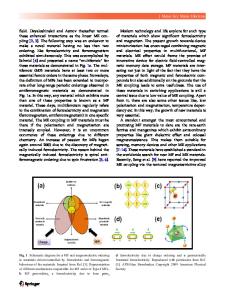Materials Challenges and Applications of Solution-Processed Organic Field-Effect Transistors
- PDF / 473,531 Bytes
- 7 Pages / 612 x 792 pts (letter) Page_size
- 89 Downloads / 184 Views
and Applications of Solution-Processed Organic FieldEffect Transistors
Henning Sirringhaus and Masahiko Ando Abstract Organic field-effect transistors (FETs) are currently the focus of significant academic research and industrial development interest, as they potentially offer unique advantages over their inorganic counterparts in terms of cost reductions, compatibility with low-temperature and printing-based manufacturing, and potentially even performance. The first generation of products incorporating organic FETs is presently being introduced to the market. This article provides an overview of strategies for achieving high field-effect mobilities in solution-processed organic semiconductor films. We provide an assessment of materials challenges to meet performance and reliability requirements for a range of display and circuit applications and present an overview of state-of-the-art application demonstrations in active-matrix addressing of flexible eletrophoretic, organic light-emitting diode, and liquid-crystal displays, as well as radiofrequency identification tagging. We discuss how the unique functional properties of organic semiconductors, which allow comparatively easy integration of information processing, information storage, light emission, and light detection functions, might enable multifunctional applications that are not easy to create with other material systems.
Introduction The materials properties of conjugated small-molecule and polymer semiconductors have specific characteristics that make them suitable for applications that cannot easily be addressed by many inorganic materials. Organic semiconductors (OSCs) are inherently low-temperature materials. Because of the absence of covalent bonding between molecules, OSCs can be processed at temperatures below typically 100–150˚C from either a vapor phase or solution into high-quality thin films that exhibit a low density of electronic defects. This makes them suitable for applications with a limited temperature window during manufacturing, such as those that require a flexible plastic substrate, or applications that require integration with
676
other low-temperature materials such as biological molecules. Solution-processable organic semiconductors are compatible with direct-write printing-based manufacturing techniques. These methods have become of interest to achieve cost reductions in large-area electronic applications, such as flat-panel displays. For many years, the performance of organic field-effect transistors (FETs) [often interchangeably referred to also as organic thin-film transistors (TFTs)] as measured by the field-effect mobility seemed to be inherently lower than that of their inorganic counterparts. Amorphous silicon (a-Si) and polycrystalline TFTs have characteristic mobilities on the order of 0.5–1 and 100 cm2/(V s), respectively.
Only vacuum-sublimed organic FETs, such as those based on pentacene, appeared to be able to reach mobility values around 1 cm2/(V s), whereas most organic TFTs based on solution-processable organic
Data Loading...











